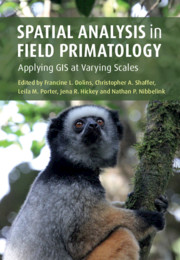Book contents
- Spatial Analysis in Field Primatology
- Spatial Analysis in Field Primatology
- Copyright page
- Dedication
- Contents
- Contributors
- Acknowledgments
- 1 Why Place Matters, and its Use in Primate Behavioral and Ecological Research
- Part I GPS for Primatologists
- Part II GIS Analysis in Fine-Scale Space
- Introduction
- 7 Home Range Analysis
- 8 Quantifying Resource Dispersion in Free-Ranging Bearded Sakis in Guyana
- 9 Interpreting Small-Scale Patterns of Ranging by Primates
- 10 Determining the Presence of Habitual Travel Route Networks in Orangutans (Pongo pygmaeus morio) in Kutai National Park, Borneo
- 11 Finding Fruit in a Tropical Rainforest
- 12 Random Walk Analyses in Primates
- 13 The Use of Small-Scale Spatial Analysis to Evaluate Primate Behavior and Welfare in Captive Settings
- 14 The Promise of Spatially Explicit Agent-Based Models for Primatology Research
- Part III GIS Analysis in Broad-Scale Space
- Index
- Plate Section (PDF Only)
- References
11 - Finding Fruit in a Tropical Rainforest
A Comparison of the Foraging Patterns of Two Distinct Fruit-Eating Primates Across Years
from Part II - GIS Analysis in Fine-Scale Space
Published online by Cambridge University Press: 29 January 2021
- Spatial Analysis in Field Primatology
- Spatial Analysis in Field Primatology
- Copyright page
- Dedication
- Contents
- Contributors
- Acknowledgments
- 1 Why Place Matters, and its Use in Primate Behavioral and Ecological Research
- Part I GPS for Primatologists
- Part II GIS Analysis in Fine-Scale Space
- Introduction
- 7 Home Range Analysis
- 8 Quantifying Resource Dispersion in Free-Ranging Bearded Sakis in Guyana
- 9 Interpreting Small-Scale Patterns of Ranging by Primates
- 10 Determining the Presence of Habitual Travel Route Networks in Orangutans (Pongo pygmaeus morio) in Kutai National Park, Borneo
- 11 Finding Fruit in a Tropical Rainforest
- 12 Random Walk Analyses in Primates
- 13 The Use of Small-Scale Spatial Analysis to Evaluate Primate Behavior and Welfare in Captive Settings
- 14 The Promise of Spatially Explicit Agent-Based Models for Primatology Research
- Part III GIS Analysis in Broad-Scale Space
- Index
- Plate Section (PDF Only)
- References
Summary
Tamarins and chimpanzees differ in many aspects of their behavior, biology, and evolutionary history; however, both primates are heavily dependent on a diet of ripe fruits during all months of the year (reviewed in Digby et al. 2011; Stumpf 2011). In addition, previous research on cognition in tamarins and chimpanzees indicates that individuals retain spatial information concerning the location of many feeding sites (e.g., Garber 2000; Janmaat et al. 2013a; Normand et al. 2009). Since primates show a high level of site fidelity (Janmaat et al. 2009) and commonly rely on sessile food sources that are revisited many times over a limited part of the year (such as termite nests and trees producing fruits, leaves, flowers, and/or exudates), one might expect foragers to reuse a limited set of travel routes, return to previously visited feeding sites, and search for new food patches in locations nearby current feeding sites.
- Type
- Chapter
- Information
- Spatial Analysis in Field PrimatologyApplying GIS at Varying Scales, pp. 225 - 246Publisher: Cambridge University PressPrint publication year: 2021
References
- 1
- Cited by

